

On the Beach at Night by Walt Whitman. Annie Proulx: “Rough Deeds” Reflections: Within the Context of No-context. Wonder was the grace of the country.

Any action could be justified by that: the wonder it was rooted in. Period followed period, and finally the wonder was that things could be built so big. A Sweet, Sad Animated Short Film, Based on an E.B. White Story. Wallace-amherst_review-the_planet. Good Old Wallace. Some General Instructions by Kenneth Koch.
Pink and White by Deborah Garrison. Share. John Berryman, "Life, friends, is boring" Somewhere or Other by Christina Rossetti. Somewhere or other there must surely be The face not seen, the voice not heard, The heart that not yet—never yet—ah me!
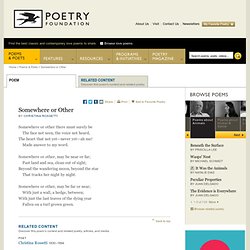
Made answer to my word. Somewhere or other, may be near or far; Past land and sea, clean out of sight; Beyond the wandering moon, beyond the star That tracks her night by night. Somewhere or other, may be far or near; "Reality TV" by Ernest Hilbert - E-Verse Radio. A.M. Homes: A Real Doll. To Build a Fire. Summary of 1908 story[edit] At 9:00 a.m. on an extremely cold winter's day (−75 °F or −59 °C),[2] an unnamed man leaves the Yukon Trail, expecting to reach his associates (referred to as "the boys") by six o'clock at a claim "on the left fork of Henderson Creek.

" "The man," as he is called throughout the story, is accompanied only by a dog, "a big native husky, the proper wolf dog," who "knew that it was no time for traveling. " But the cold does not deter the man, a relative newcomer to the Yukon. He proceeds along a creek trail, taking care to avoid hidden springs.
Twenty-One Poems for AP Literature and Composition. Click here for the related feature, "Fiction and Non-Fiction for AP English Literature and Composition.

" The selections within this listing represent frequently taught poets and poems in AP English Literature and Composition. For each of the twenty-one poems or poetic forms for AP Literature and Composition, students and teachers will find a link to the poem and multimedia resources. These include EDSITEment lessons as well as EDSITEment-reviewed websites that discuss the poem, the poet, and its context. Media incorporated in these resources include audio clips and video as well as primary source documents and photographs, along with other useful tools such as timelines. They offer both the content and skills needed to support student success in AP English Literature and Composition. EDSITEment also offers a Literary Glossary of terms cross-referenced with EDSITEment lessons. Queen-Anne’s Lace by William Carlos Williams.
Her body is not so white as anemony petals nor so smooth—nor so remote a thing.
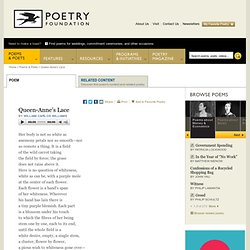
It is a field of the wild carrot taking the field by force; the grass. To a Mouse. "To a Mouse, on Turning Her Up in Her Nest with the Plough"[1] is a Scots poem written by Robert Burns in 1785, and was included in the Kilmarnock volume.[2] According to legend, Burns wrote the poem after finding a nest full of mice during the winter.
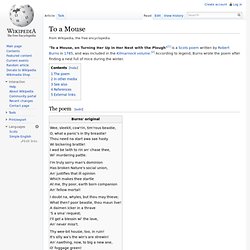
The poem[edit] In other media[edit] My life closed twice before its close; The Zoo Society » Snide Tempered Logic. Edward Albee’s The Zoo Story is about society fighting with itself. The two characters take on a personification of two different sides of society. While Peter, for the most part personifies society itself, Jerry offers an introspection of society through an outsider’s perception. Of course Jerry is biased in this way and may not allow the best introspection but that is his goal in forcing Peter to see himself in a different light. This suggests Albee is speaking to us through Jerry. Albee even gave Jerry a title of hero in an interview by the author Matthew Roudane. This is used to make the character believable in a development standpoint, to make his beliefs have reason behind them, and to allow his second role to take place. Haruki Murakami: “Samsa in Love” He woke to discover that he had undergone a metamorphosis and become Gregor Samsa.
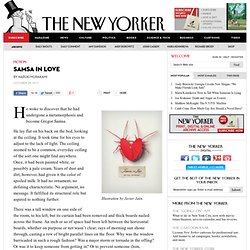
He lay flat on his back on the bed, looking at the ceiling. It took time for his eyes to adjust to the lack of light. The Chambered Nautilus, Oliver Wendell Holmes Sr. T he living nautilus actually lives only in the outermost, largest chamber of its shell.
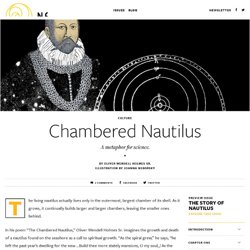
As it grows, it continually builds larger and larger chambers, leaving the smaller ones behind. In his poem “The Chambered Nautilus,” Oliver Wendell Holmes Sr. imagines the growth and death of a nautilus found on the seashore as a call to spiritual growth. “As the spiral grew,” he says, “he left the past year’s dwelling for the new …Build thee more stately mansions, O my soul, / As the swift seasons roll!
Leave thy low-vaulted past! Shovel Kings: A Story by Edna O’Brien : The Thought Fox. Saints and Sinners is a new collection of short stories by the award-winning Edna O’Brien who, since her debut novel The Country Girls (1960), has published over twenty works of fiction.

Sucker-by-carson-mccullers-SEP. 2013 Obits — an Epic Poem. Franz Kafka’s It’s a Wonderful Life. Dreams. A. A. Milne Poems and Poetry. George Saunders: Sea Oak. Short Story. SEA OAK by George Saunders AT SIX MR.

Rare 1959 Audio: Flannery O’Connor Reads ‘A Good Man is Hard to Find’ Flannery O'Connor was a Southern writer who, as Joyce Carol Oates once said, had less in common with Faulkner than with Kafka and Kierkegaard. Isolated by poor health and consumed by her fervent Catholic faith, O'Connor created works of moral fiction that, according to Oates, “were not refined New Yorker stories of the era in which nothing happens except inside the characters' minds, but stories in which something happens of irreversible magnitude, often death by violent means. " In imagining those events of irreversible magnitude, O'Connor could sometimes seem outlandish--even cartoonish--but she strongly rejected the notion that her perceptions of 20th century life were distorted. Fiction Podcast: Tony Earley Reads William Maxwell. In this month’s fiction podcast, Tony Earley reads “Love,” by William Maxwell, who was the fiction editor at The New Yorker from 1936 until 1975.
The story, which first appeared in the magazine in 1983, is narrated by an older man looking back on his fifth-grade teacher, a young woman who was adored by her students but fell ill and left school midway through the year. Earley, whose own short stories have been appearing in the magazine since 1999, compares Maxwell’s style to Willa Cather’s; he says that he was drawn to Maxwell’s traditional American storytelling and to his fearlessness in writing “emotionally about emotions.” “Love” is concise and simply written, but its details accumulate in subtly powerful ways. The Iceberg: A Story by Zelda Fitzgerald.